Adsorption and Kinetics Studies of Cr (VI) by Graphene Oxide and Reduced Graphene Oxide-Zinc Oxide Nanocomposite
Abstract
1. Introduction
2. Results
2.1. Characterization
2.1.1. X-ray Diffraction
2.1.2. Scanning Electron Microscopy
2.1.3. Fourier Transform Infrared Spectroscopy
2.1.4. UV-Vis Spectroscopy
2.2. Water Purification by Adsorption
2.2.1. Effect of the Initial Concentration
2.2.2. Effect of pH
2.2.3. Effect of Temperature
2.2.4. Effect of Contact Time
2.2.5. Effect of Adsorbent Mass
2.3. Kinetic of Adsorption
2.4. Thermodynamic Studies
2.5. Activation Parameter
3. Materials and Methods
3.1. Reagents
3.2. Synthesis of GO
3.3. Synthesis of rGO-ZnO Nanocomposite
3.4. Characterization
3.5. Adsorption Study
4. Conclusions
Author Contributions
Funding
Institutional Review Board Statement
Informed Consent Statement
Data Availability Statement
Conflicts of Interest
Sample Availability
References
- El-Nour, K.M.M.A.; Al-Warthan, A.; Ammar, R.A.A. Synthesis and applications of silver nanoparticles. Arab. J. Chem. 2010, 135, 135–140. [Google Scholar] [CrossRef]
- Naseem, T.; Durrani, T. The role of some important metal oxide nanoparticles for wastewater and antibacterial applications: A review. Environ. Chem. Ecotoxicol. 2021, 3, 59–75. [Google Scholar] [CrossRef]
- Shoukat, S.; Rehman, W.; Haq, S.; Waseem, M.; Shah, A. Synthesis and characterization of zinc stannate nanostructures for the adsorption of chromium (VI) ions and photo-degradation of rhodamine 6G. Mater. Res. Express 2019, 6, 115052. [Google Scholar] [CrossRef]
- Hebbar, R.S.; Isloor, A.M.; Ananda, K.; Ismail, A.F. Fabrication of polydopamine functionalized halloysite nanotube/polyetherimide membranes for heavy metal removal. J. Mater. Chem. A 2016, 4, 764–774. [Google Scholar] [CrossRef]
- Iqbal, M.; Zain-ul-Abdin; Naseem, T.; Waseem, M.; Din, S.U.; Hafeez, M.; Haq, S.; Qureshi, S.; Bibi, A.; Rehman, S.U.; et al. Synthesis and Characterization of rGO/Ag2O Nanocomposite and its Use for Catalytic Reduction of 4-Nitrophenol and Photocatalytic Activity. J. Inorg. Organomet. Polym. Mater. 2021, 31, 100–111. [Google Scholar] [CrossRef]
- Al-Shannag, M.; Al-Qodah, Z.; Bani-Melhem, K.; Rasool, M. Heavy metal ions removal from metal plating wastewater using electrocoagulation: Kinetic study and process performance. Chem. Eng. J. 2015, 260, 749–756. [Google Scholar] [CrossRef]
- Brillas, E.; Martínez-Huitle, C.A. Decontamination of wastewaters containing synthetic organic dyes by electrochemical methods. An updated review. Appl. Catal. B Environ. 2015, 166–167, 603–643. [Google Scholar] [CrossRef]
- Haq, S.; Rehman, W.; Rehman, M. Modeling, Thermodynamic Study and Sorption Mechanism of Cadmium Ions onto Isopropyl Alcohol Mediated Tin Dioxide Nanoparticles. J. Inorg. Organomet. Polym. Mater. 2020, 30, 1197–1205. [Google Scholar] [CrossRef]
- Zewail, T.M. Kinetic study of heavy metal ions removal by ion exchange in batch conical air spouted bed. Alex. Eng. J. 2015, 54, 83–90. [Google Scholar] [CrossRef]
- Zhang, Y.; Chen, Y.; Westerhoff, P.; Hristovski, K.; Crittenden, J.C. Stability of commercial metal oxide nanoparticles in water. Water Res. 2008, 42, 2204–2212. [Google Scholar] [CrossRef]
- Shoukat, S.; Haq, S.; Rehman, W.; Waseem, M.; Hafeez, M.; Din, S.U.; Zain-ul-Abdin; Ahmad, P.; Rehman, M.U.; Shah, A.; et al. Remediation of Chromium (VI) and Rhodamine 6G via Mixed Phase Nickel-Zinc Nanocomposite: Synthesis and Characterization. J. Inorg. Organomet. Polym. Mater. 2021, 31, 1565–1575. [Google Scholar] [CrossRef]
- Jang, E.; Pack, S.P.; Kim, I.; Chung, S. A systematic study of hexavalent chromium adsorption and removal from aqueous environments using chemically functionalized amorphous and mesoporous silica nanoparticles. Sci. Rep. 2020, 10, 1–20. [Google Scholar] [CrossRef] [PubMed]
- Chen, Y.; An, D.; Sun, S.; Gao, J.; Qian, L. Reduction and Removal of Chromium VI in Water. Materials 2018, 11, 269. [Google Scholar] [CrossRef] [PubMed]
- Zu, S.; Ahmad, N.; Norharyati, W.; Salleh, W.; Fauzi, A.; Yusof, N.; Zamri, M.; Yusop, M.; Aziz, F. Chemosphere Adsorptive removal of heavy metal ions using graphene-based nanomaterials: Toxicity, roles of functional groups and mechanisms. Chemosphere 2020, 248, 126008. [Google Scholar] [CrossRef]
- Sahebjamee, N.; Soltanieh, M.; Mahmoud, S.; Heydarinasab, A. Removal of Cu2+, Cd2+ and Ni2+ ions from aqueous solution using a novel chitosan/polyvinyl alcohol adsorptive membrane. Carbohydr. Polym. 2019, 210, 264–273. [Google Scholar] [CrossRef] [PubMed]
- Haq, S.; Shoukat, S.; Rehman, W.; Waseem, M.; Shah, A. Green fabrication and physicochemical investigations of zinc-cobalt oxide nanocomposite for wastewater treatment. J. Mol. Liq. 2020, 318, 114260. [Google Scholar] [CrossRef]
- Aluigi, A.; Tonetti, C.; Vineis, C.; Varesano, A.; Tonin, C.; Casasola, R. Study on the Adsorption of Chromium (VI) by Hydrolyzed Keratin/Polyamide 6 Blend Nanofibres. J. Nanosci. Nanotechnol. 2012, 12, 7250–7259. [Google Scholar] [CrossRef] [PubMed]
- Gupta, V.K.; Ali, I.; Saleh, T.A.; Siddiqui, M.N.; Agarwal, S. Chromium removal from water by activated carbon developed from waste rubber tires. Environ. Sci. Pollut. Res. 2013, 20, 1261–1268. [Google Scholar] [CrossRef] [PubMed]
- Ren, T.; He, P.; Niu, W.; Wu, Y. Synthesis of α-Fe2O3 nanofibers for applications in removal and recovery of Cr(VI) from wastewater. Environ. Sci. Pollut. Res. 2013, 20, 155–162. [Google Scholar] [CrossRef] [PubMed]
- Yadav, K.K.; Gupta, N.; Kumar, V.; Singh, J.K. Bioremediation of heavy metals from contaminated sites using potential species: A review. Indian J. Environ. Prot. 2017, 37, 65–84. [Google Scholar]
- Rodwihok, C.; Wongratanaphisan, D.; Linh, Y.; Ngo, T. Effect of GO Additive in ZnO/rGO Nanocomposites with Enhanced Photosensitivity and Photocatalytic Activity. Nanomaterials 2019, 9, 1441. [Google Scholar] [CrossRef] [PubMed]
- Singh, S.; Anil, A.G.; Khasnabis, S.; Kumar, V.; Nath, B.; Adiga, V.; Kumar, T.S.S.; Subramanian, S.; Kumar, V.; Singh, J.; et al. Sustainable removal of Cr (VI) using graphene oxide-zinc oxide nanohybrid: Adsorption kinetics, isotherms and thermodynamics. Environ. Res. 2022, 203, 111891. [Google Scholar] [CrossRef] [PubMed]
- Barick, K.C.; Bahadur, D. Novel and efficient three dimensional Mesoporous Zno Nanoassemblies for. Int. J. Nanosci. 2011, 10, 1001–1005. [Google Scholar] [CrossRef]
- Wang, X.; Cai, W.; Liu, S.; Wang, G.; Wu, Z.; Zhao, H. ZnO hollow microspheres with exposed porous nanosheets surface: Structurally enhanced adsorption towards heavy metal ions. Colloids Surf. A Physicochem. Eng. Asp. 2013, 422, 199–205. [Google Scholar] [CrossRef]
- Haq, S.; Afsar, H.; Ali, M.B.; Almalki, M.; Albogami, B.; Hedfi, A. Green Synthesis and Characterization of a ZnO–ZrO2 Heterojunction for Environmental and Biological Applications. Crystals 2021, 11, 1502. [Google Scholar] [CrossRef]
- Durmus, Z.; Kurt, Z.; Durmus, A. Synthesis and Characterization of Graphene Oxide/Zinc Oxide (GO/ZnO) Nanocomposite and Its Utilization for Photocatalytic Degradation of Basic Fuchsin Dye. Chem. Sel. 2019, 4, 271–278. [Google Scholar] [CrossRef]
- Madhuri, K.P.; Bramhaiah, K.; John, N.S. Nanoscale photocurrent distribution in ultra-thin films of zinc oxide nanoparticles and their hybrid with reduced graphene oxide. Mater. Res. Express 2016, 1, 35004. [Google Scholar] [CrossRef]
- Narayanan, G.N.; Gokula Deepan, P.; Karthigeyan, A. Structural and optical properties of zinc oxide-reduced graphene oxide nanocomposite thin films prepared by hydrothermal method. Int. J. Chem. Tech. Res. 2015, 7, 1065–1071. [Google Scholar]
- Zheng, J.Y.; Tan, J.; Jun, X. Magnetic Co-Fe bimetallic nanoparticle containing modifiable microgels for the removal of heavy metal ions, organic dyes and herbicides from aqueous media. RSC Adv. 2015, 5, 62314–62318. [Google Scholar] [CrossRef]
- Zhao, G.; Wu, X.; Tan, X.; Wang, X. Sorption of Heavy Metal Ions from Aqueous Solutions: A Review. Open Colloid Sci. J. 2011, 4, 19–31. [Google Scholar] [CrossRef]
- Isotherm, A.; Naseem, K.; Huma, R.; Shahbaz, A.; Jamal, J.; Zia, M.; Rehman, U.; Sharif, A.; Ahmed, E.; Begum, R.; et al. Extraction of Heavy Metals from Aqueous Medium by Husk Biomass: Extraction of Heavy Metals from Aqueous Medium by Husk Biomass: Adsorption Isotherm, Kinetic and Thermodynamic study. Z. Phys. Chem. 2018, 233, 201–223. [Google Scholar] [CrossRef]
- Muthukumaran, C.; Murugaiyan, V. Adsorption isotherms and kinetic studies of crystal violet dye removal from aqueous solution using surfactant modified magnetic nanoadsorbent. J. Taiwan Inst. Chem. Eng. 2016, 63, 354–362. [Google Scholar] [CrossRef]
- Fu, F.; Wang, Q. Removal of heavy metal ions from wastewaters: A review. J. Environ. Manag. 2011, 92, 407–418. [Google Scholar] [CrossRef] [PubMed]
- Ahmadi, A.; Foroutan, R.; Esmaeili, H.; Tamjidi, S. The role of bentonite clay and bentonite clay@MnFe2O4 composite and their physico-chemical properties on the removal of Cr (III) and Cr (VI) from aqueous media. Environ. Sci. Pollut. Res. 2020, 27, 14044–14057. [Google Scholar] [CrossRef] [PubMed]
- Baral, S.S.; Das, S.N.; Rath, P.; Chaudhury, G.R. Chromium (VI) removal by calcined bauxite. Biochem. Eng. J. 2007, 34, 69–75. [Google Scholar] [CrossRef]
- Gupta, V.K.; Carrott, P.J.M.; Ribeiro Carrott, M.M.L.; Suhas. Low-Cost adsorbents: Growing approach to wastewater treatment—A review. Crit. Rev. Environ. Sci. Technol. 2009, 39, 783–842. [Google Scholar] [CrossRef]
- Ying, L.; Qinyan, Y.; Baoyu, G.; Qian, L.; Chunling, L. Adsorption thermodynamic and kinetic studies of dissolved chromium onto humic acids. Colloids Surf. B Biointerfaces 2008, 65, 25–29. [Google Scholar] [CrossRef]
- Bhattacharya, A.K.; Naiya, T.K.; Mandal, S.N.; Das, S.K. Adsorption, kinetics and equilibrium studies on removal of Cr (VI) from aqueous solutions using different low-cost adsorbents. Chem. Eng. J. 2008, 137, 529–541. [Google Scholar] [CrossRef]
- Gupta, V.K. Application of low-cost adsorbents for dye removal–a review. J. Environ. Manag. 2009, 90, 2313–2342. [Google Scholar] [CrossRef] [PubMed]
- Debnath, S.; Ghosh, U.C. Kinetics, isotherm and thermodynamics for Cr (III) and Cr (VI) adsorption from aqueous solutions by crystalline hydrous titanium oxide. J. Chem. Thermodyn. 2008, 40, 67–77. [Google Scholar] [CrossRef]
- Kumar, N.; Samarpita, M. Adsorption of Cr (VI) from aqueous solution on graphene oxide (GO) prepared from graphite: Equilibrium, kinetic and thermodynamic studies. Appl. Water Sci. 2020, 10, 1–10. [Google Scholar] [CrossRef]
- Naiya, T.K.; Bhattacharya, A.K.; Das, S.K. Adsorption of Cd (II) and Pb (II) from aqueous solutions on activated alumina. J. Colloid Interface Sci. 2009, 333, 14–26. [Google Scholar] [CrossRef] [PubMed]
- Rahman, N.; Ullah, I.; Alam, S.; Khan, M.S.; Shah, L.A.; Zekker, I.; Burlakovs, J. Activated Ailanthus altissima Sawdust as Adsorbent for Removal of Acid Yellow 29 from Wastewater: Kinetics Approach. Water 2021, 13, 2136. [Google Scholar] [CrossRef]
- Alam, S.; Khan, M.S.; Bibi, W.; Zekker, I.; Burlakovs, J.; Ghangrekar, M.M. Preparation of Activated Carbon from the Wood of Paulownia tomentosa as an Efficient Adsorbent for the Removal of Acid Red 4 and Methylene Blue Present in Wastewater. Water 2021, 13, 1453. [Google Scholar] [CrossRef]
- Wahab, M.; Zahoor, M.; Salman, S.M.; Kamran, A.W.; Naz, S. Adsorption-membrane hybrid approach for the removal of azithromycin from water: An attempt to minimize drug resistance problem. Water 2021, 13, 1969. [Google Scholar] [CrossRef]
- Jabeen, S.; Khan, M.S.; Khattak, R.; Zekker, I.; Burlakovs, J.; Rubin, S.S.C. Palladium-supported zirconia-based catalytic degradation of rhodamine-b dye from wastewater. Water 2021, 13, 1522. [Google Scholar] [CrossRef]
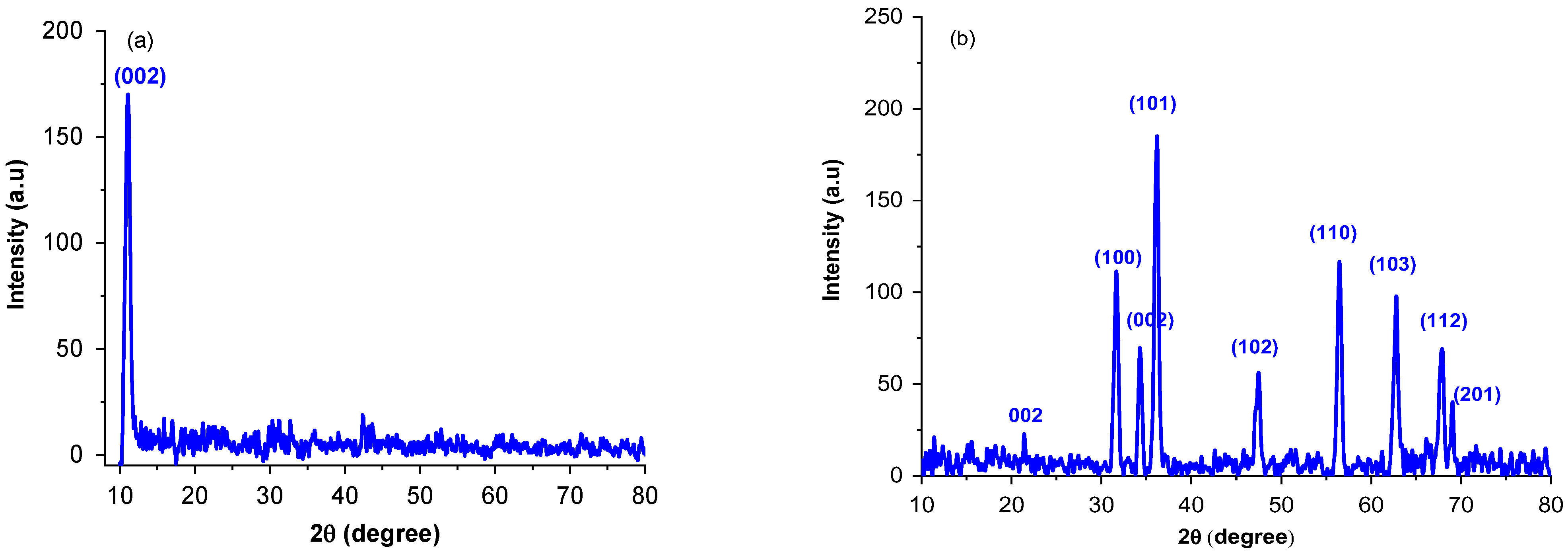
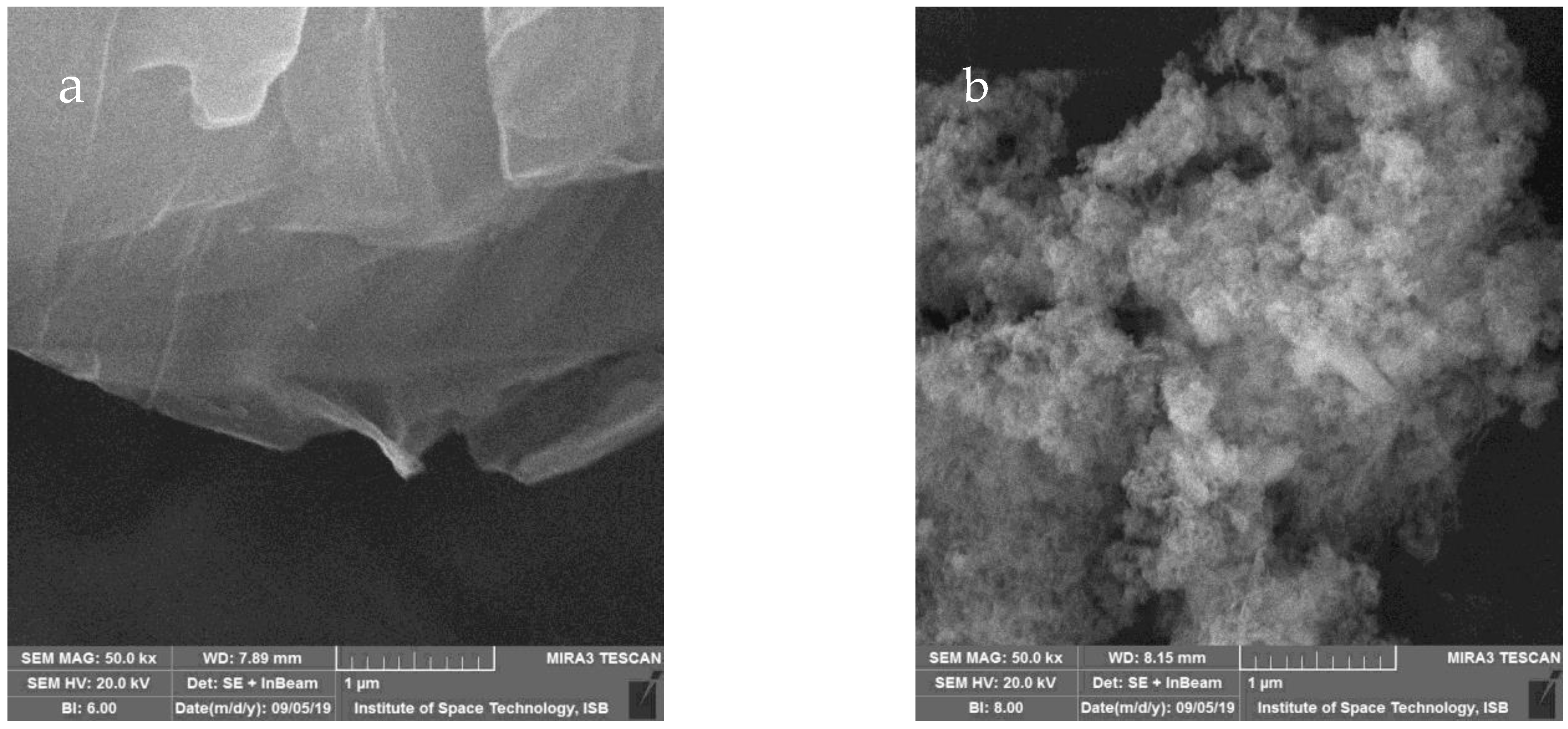
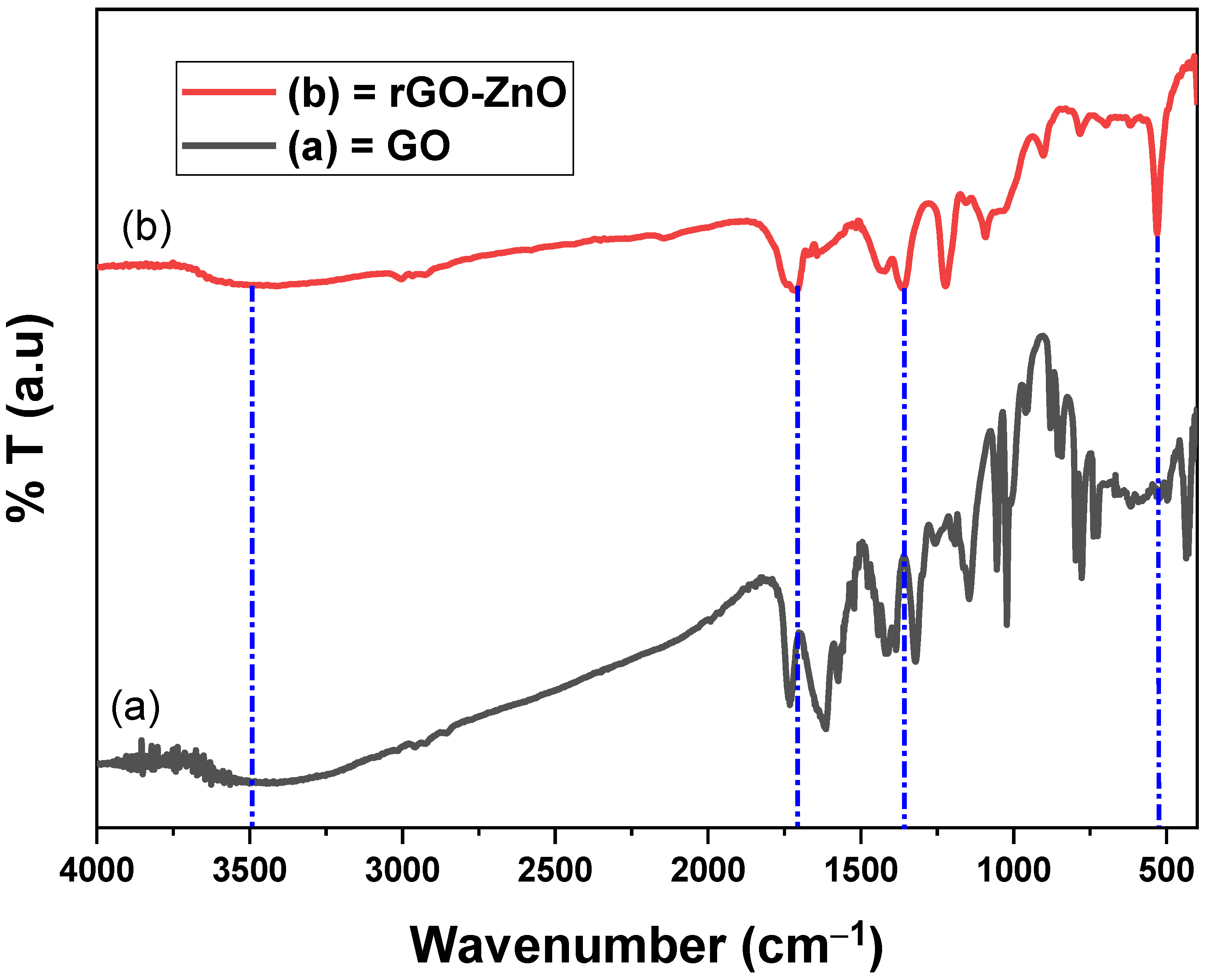
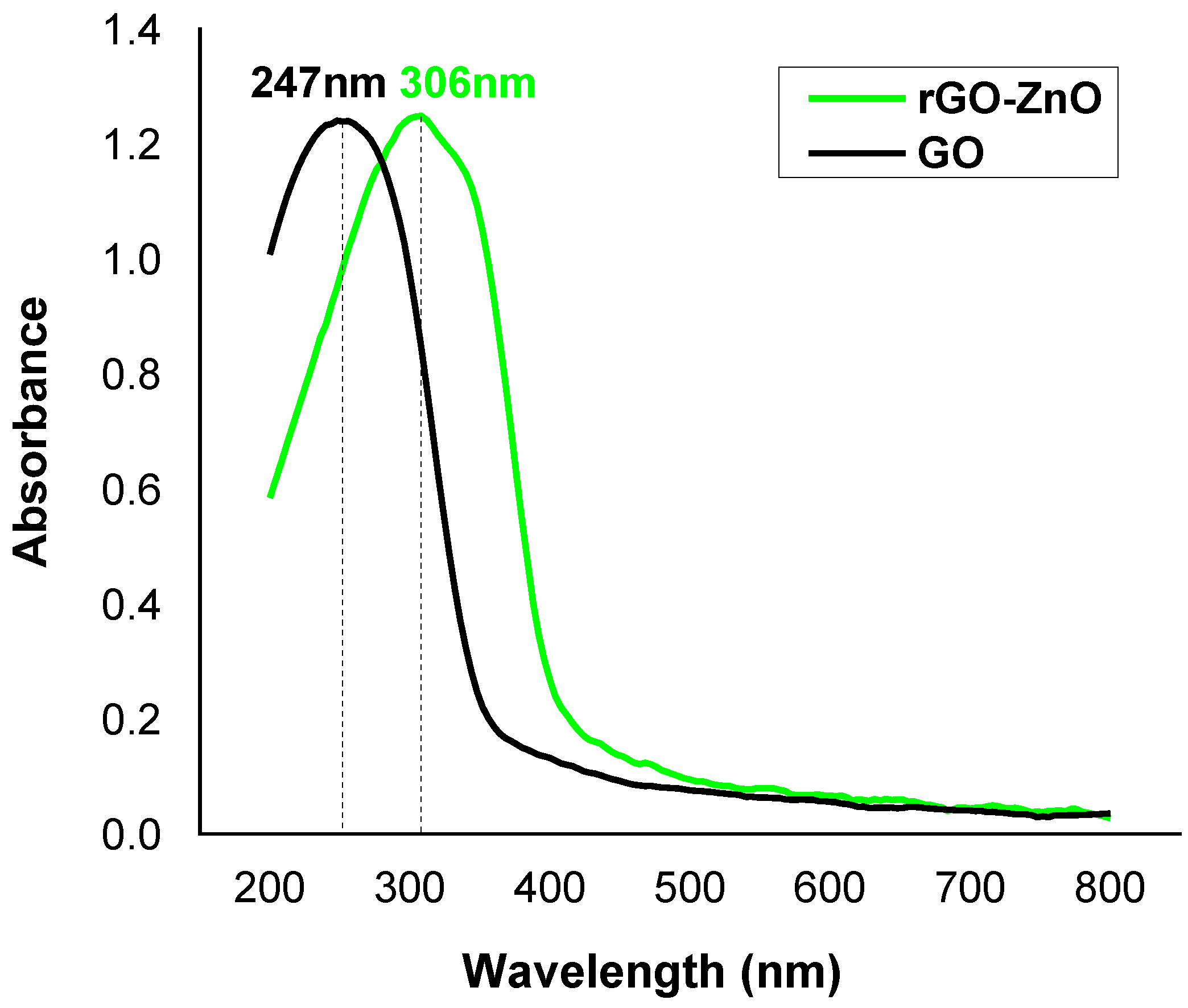

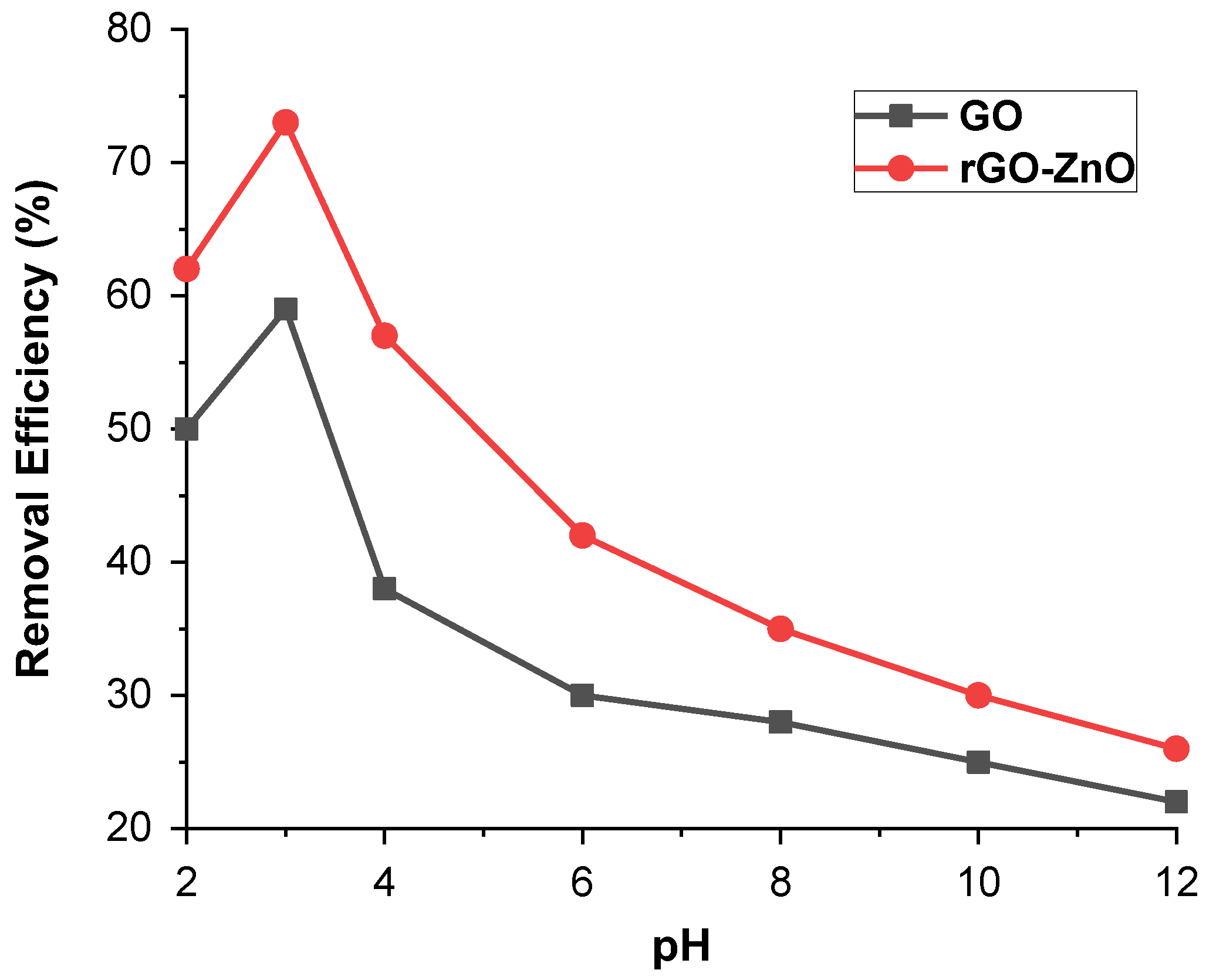
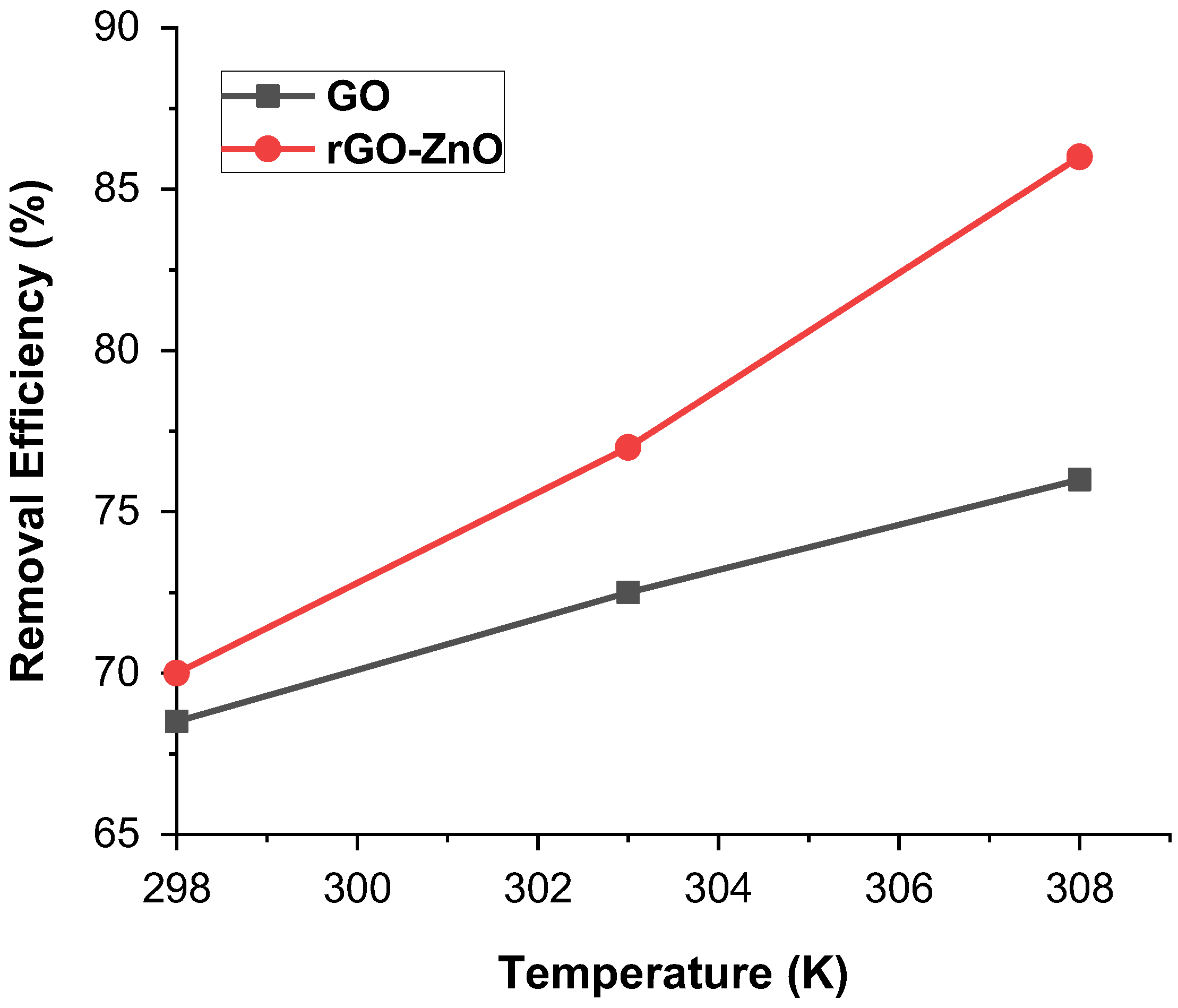
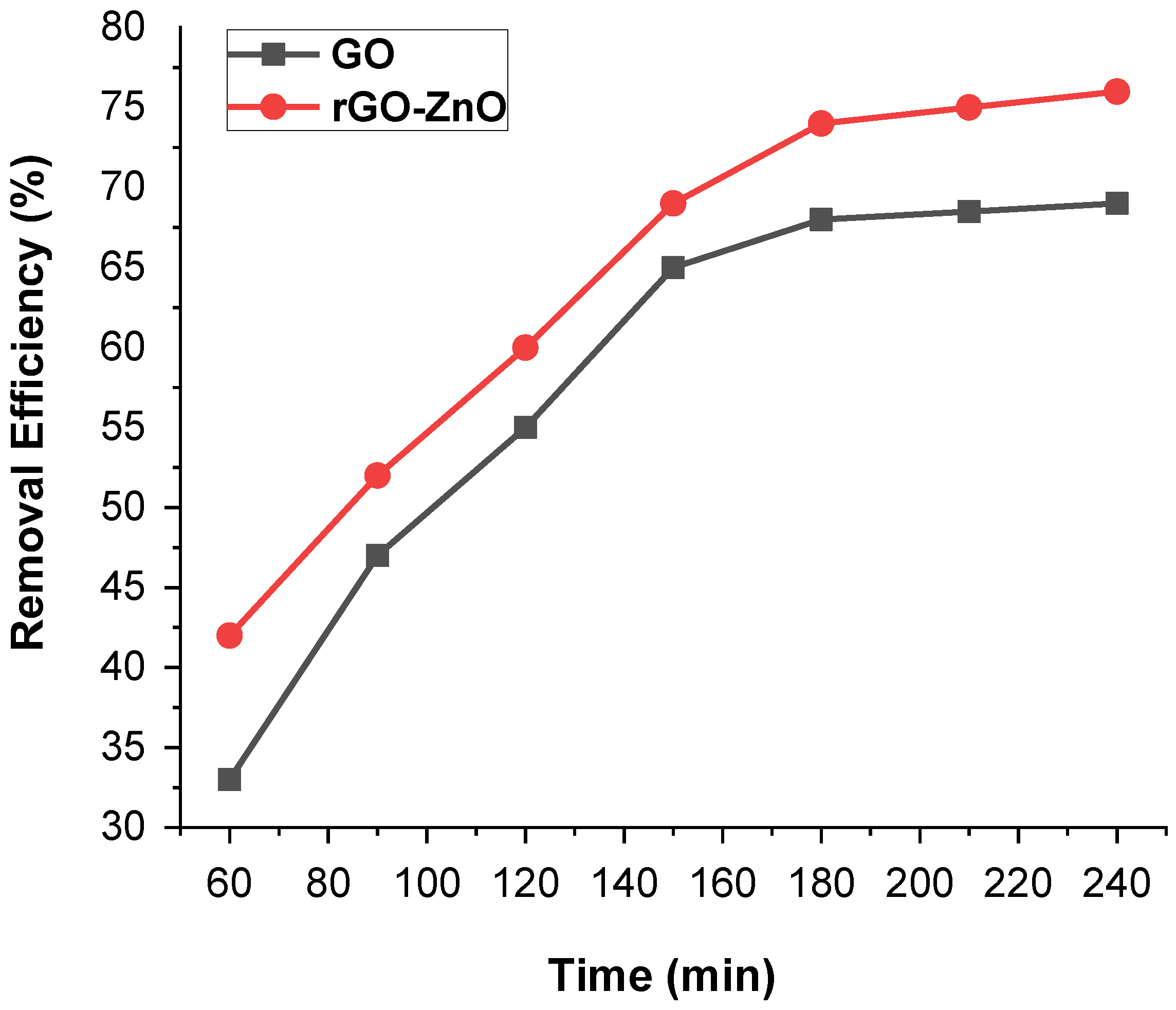
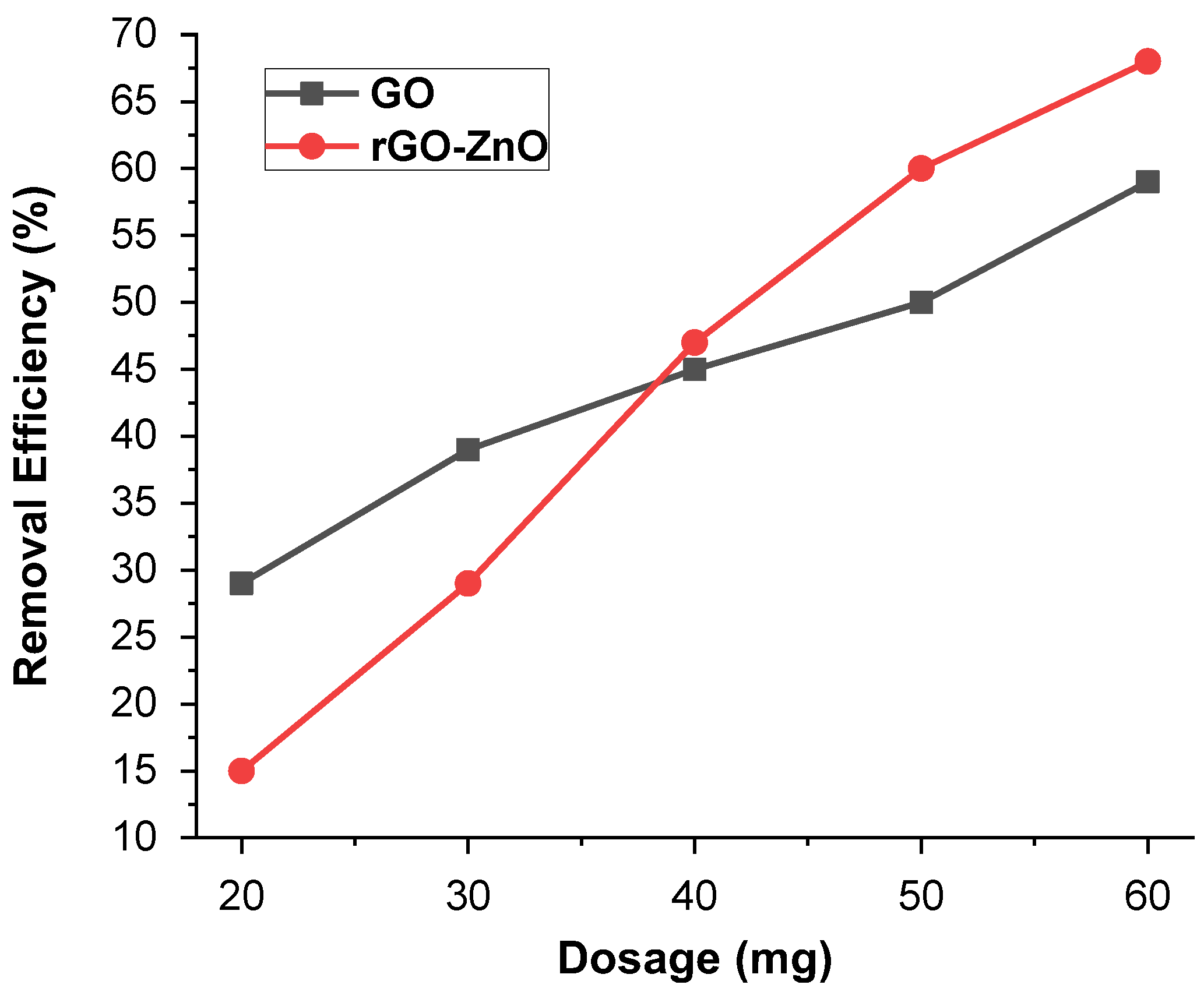
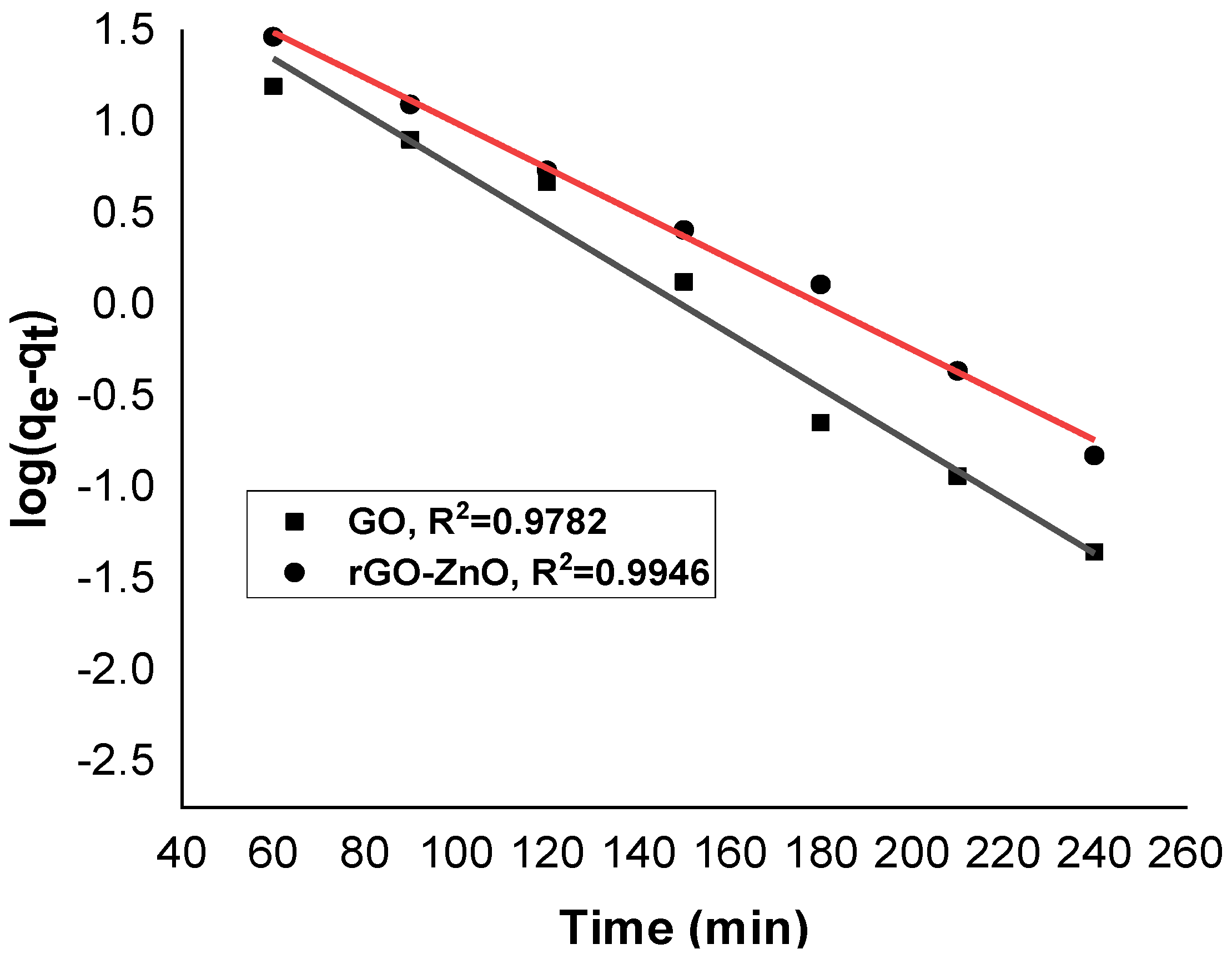
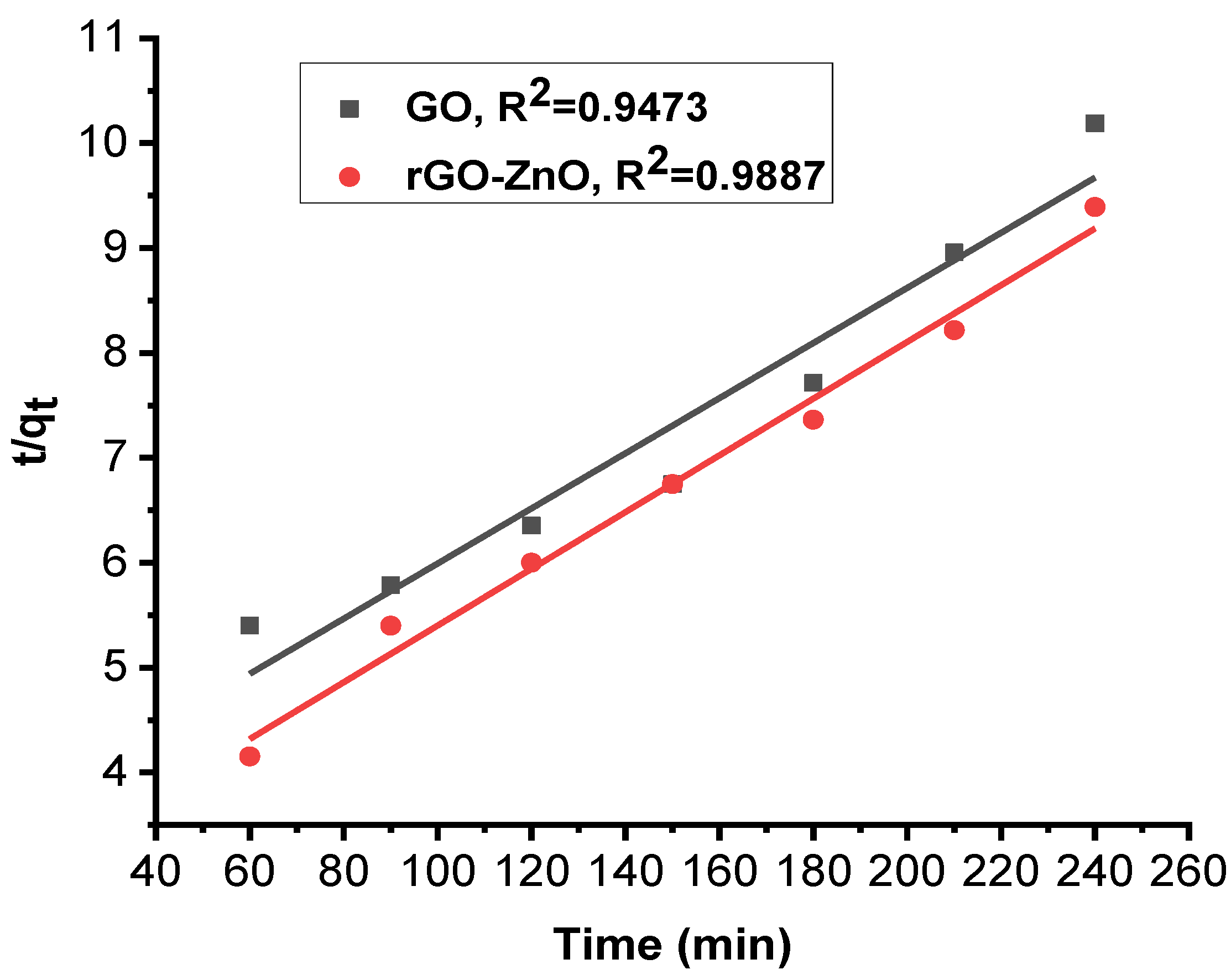
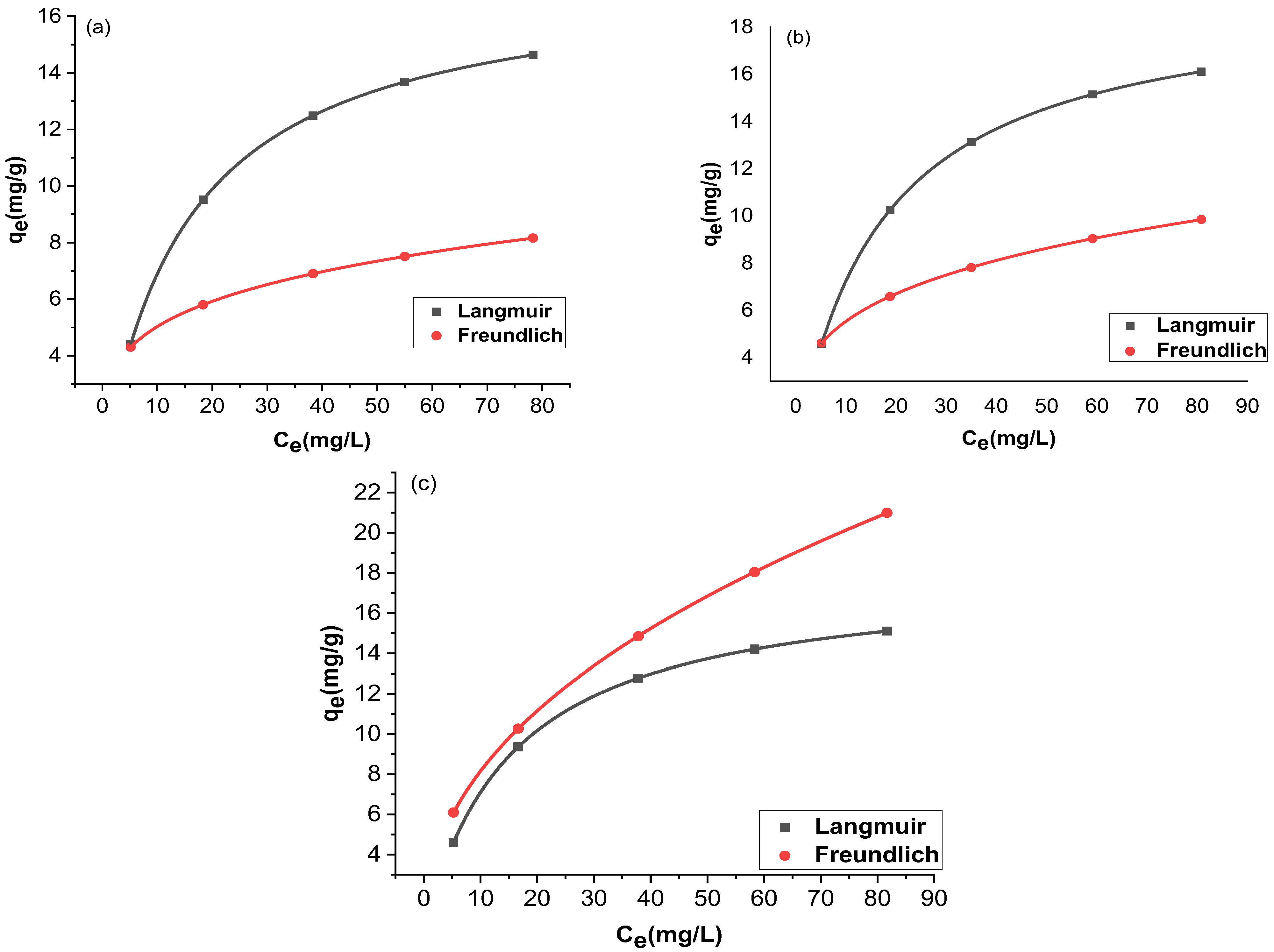
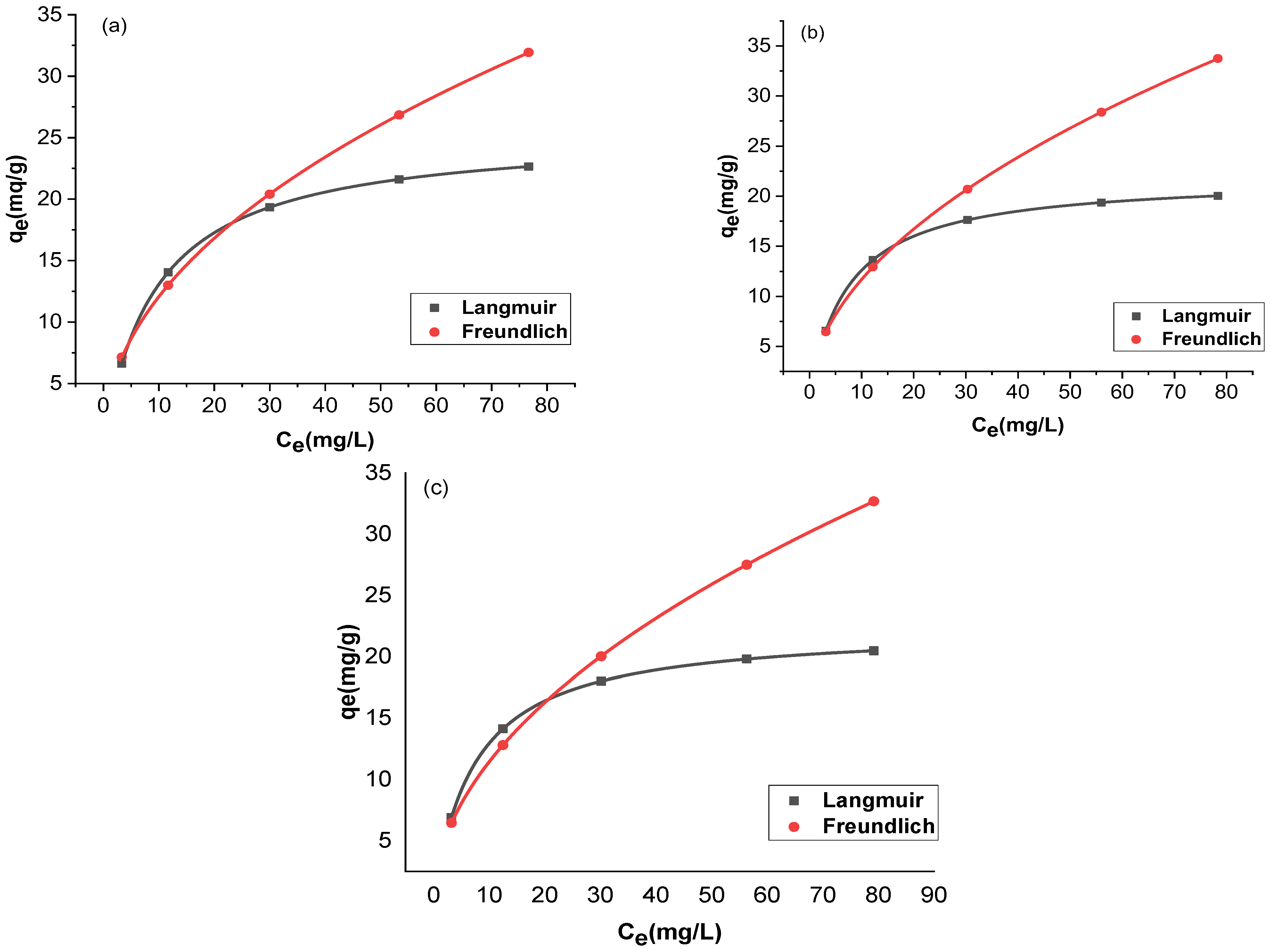
| Sample | Temp. (K) | Langmuir Parameters | Freundlich Parameters | ||||
|---|---|---|---|---|---|---|---|
| R2 | KL | qm (mg/g) | R2 | Kf | 1/n | ||
| GO | 298 | 1 | 0.06 | 17.50 | 0.999 | 0.59 | 0.24 |
| 303 | 1 | 0.06 | 19.49 | 0.999 | 0.59 | 0.28 | |
| 308 | 1 | 0.07 | 17.92 | 0.998 | 0.58 | 0.46 | |
| rGO-ZnO | 298 | 1 | 1.06 | 25.45 | 0.999 | 0.40 | 0.48 |
| 303 | 1 | 0.14 | 21.92 | 0.999 | 0.36 | 0.52 | |
| 308 | 1 | 0.14 | 22.37 | 0.998 | 0.36 | 0.51 | |
| Adsorbent | qm (mg/g) | References |
|---|---|---|
| Bentonite clay | 0.572 | [37] |
| Calcined bauxite | 2.021 | [38] |
| Fly ash | 23.86 | [39] |
| Humic acid | 2.75 | [40] |
| Fuller’s earth | 23.58 | [41] |
| Activated alumina | 25.75 | [42] |
| Crystalline hydrous titanium oxide | 20.00 | [40] |
| GO | 1.222 | [44] |
| GO | 19.49 | Present study |
| rGO-ZnO Nanocomposite | 25.45 | Present study |
| Temp (K) | ΔS (kJ/(mol K)) | △H (kJ/mol) | ΔG (kJ/mol) | |
|---|---|---|---|---|
| GO | 298 | 3.91 | 8.136 | −2420 |
| 303 | −2461 | |||
| 308 | −2502 | |||
| rGO-ZnO | 298 | 49.02 | 20.086 | −5936 |
| 303 | −6036 | |||
| 308 | −6137 |
| Temp. (K) | 1/T | ln K | Ea (kJ/mol) | |
|---|---|---|---|---|
| GO | 298 | 3.3 | −2.7 | 8.14 |
| 303 | 3.3 | −2.8 | ||
| 308 | 3.2 | −2.7 | ||
| rGO-ZnO | 298 | 3.3 | −2.2 | 20.09 |
| 303 | 3.3 | −2.0 | ||
| 308 | 3.2 | −1.9 |
Publisher’s Note: MDPI stays neutral with regard to jurisdictional claims in published maps and institutional affiliations. |
© 2022 by the authors. Licensee MDPI, Basel, Switzerland. This article is an open access article distributed under the terms and conditions of the Creative Commons Attribution (CC BY) license (https://creativecommons.org/licenses/by/4.0/).
Share and Cite
Naseem, T.; Bibi, F.; Arif, S.; Waseem, M.; Haq, S.; Azra, M.N.; Liblik, T.; Zekker, I. Adsorption and Kinetics Studies of Cr (VI) by Graphene Oxide and Reduced Graphene Oxide-Zinc Oxide Nanocomposite. Molecules 2022, 27, 7152. https://doi.org/10.3390/molecules27217152
Naseem T, Bibi F, Arif S, Waseem M, Haq S, Azra MN, Liblik T, Zekker I. Adsorption and Kinetics Studies of Cr (VI) by Graphene Oxide and Reduced Graphene Oxide-Zinc Oxide Nanocomposite. Molecules. 2022; 27(21):7152. https://doi.org/10.3390/molecules27217152
Chicago/Turabian StyleNaseem, Taiba, Fozia Bibi, Saira Arif, Muhammad Waseem, Sirajul Haq, Mohamad Nor Azra, Taavi Liblik, and Ivar Zekker. 2022. "Adsorption and Kinetics Studies of Cr (VI) by Graphene Oxide and Reduced Graphene Oxide-Zinc Oxide Nanocomposite" Molecules 27, no. 21: 7152. https://doi.org/10.3390/molecules27217152
APA StyleNaseem, T., Bibi, F., Arif, S., Waseem, M., Haq, S., Azra, M. N., Liblik, T., & Zekker, I. (2022). Adsorption and Kinetics Studies of Cr (VI) by Graphene Oxide and Reduced Graphene Oxide-Zinc Oxide Nanocomposite. Molecules, 27(21), 7152. https://doi.org/10.3390/molecules27217152








